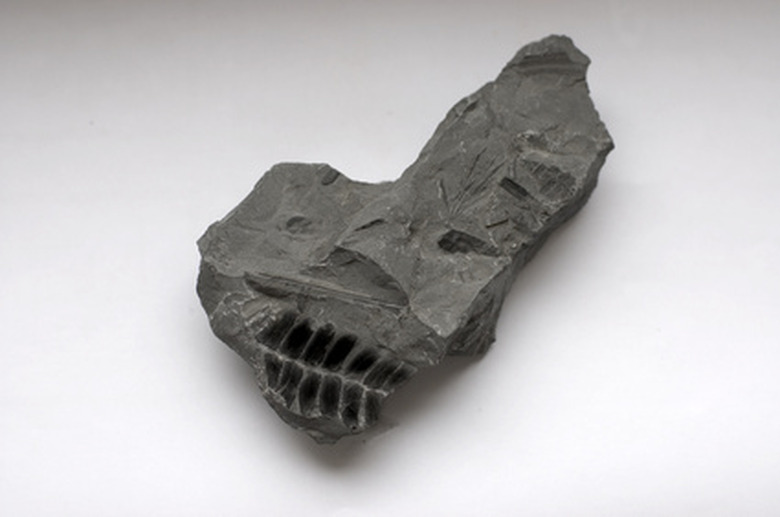Types Of Plant Fossils
Like their much larger vertebrate cousins that feature so prominently in natural history museums everywhere, plants also can become fossilized and offer us a window into the past. Plant fossils are found in one of six broad categories. However, some fossils can fall into multiple categories, or outside of any single category, according to the University of California Museum of Paleontology.
Fossils are incredibly important when uncovering information about the natural history of the world. Habitats, morphology, evolutionary history, and ecosystem development are all encoded in the fossil record, and we can use this trove of information to better understand our current environment and situation. There are many types of plant fossils, and they record everything from varieties of mosses (lycopods) to the first flowers and trees.
TL;DR (Too Long; Didn't Read)
The study of ancient and fossilized plants is called paleobotany.
Plants have existed for hundreds of millions of years, and many land plants today have even existed since the time of the dinosaurs and before. During the Mesozoic Era (the primary era of the dinosaurs containing the Triassic, Jurassic, and Cretaceous), conifers and ferns were incredibly common. In fact, the first ancient plants began to spread across land nearly 420 MYA (million years ago) during the Devonian Period of the Paleozoic Era. Following the Devonian Period, plants became even more widespread in the Carboniferous period, and Cycads (later to become one of the most abundant plant species on Earth) first appeared.
Flowering plants (also called angiosperms) did not begin to flourish until the Cretaceous period of the Mesozoic Era. They differed greatly from the pre-existing embryophytes – like ferns and horsetails (also related to calamites) – that reproduce through spores emitted from their fronds and leaves. Instead flowering plants have a much more complex system of pollination and population. Today there are many kinds of plants that cover Earth's surface. Across all plant groups, these organisms preform photosynthesis, and they are classified as eukaryotes (meaning all of their cells have a nucleus).
Compression Fossils
Compression Fossils
These plant fossils are two-dimensional imprints of plants that have been transformed during the fossilization process and smashed into a flat impression of the plant they once were. These fossils often retain some organic matter. Common examples of compression fossils can be found in coal and peat, which contain many types of accumulated fossil plants.
Impression Fossils
Impression Fossils
Impression fossils are similar to compression fossils in that they are both two-dimensional, but these fossils are not remnants of the plant itself and do not contain organic material. Impression fossils essentially leave an imprint of the plant material in some fine-grained or soft sediment, such as clay or silt. Once the plant matter decays, the impression remains to be fossilized.
Cast and Mold Fossils
Cast and Mold Fossils
Mold and cast fossils are three-dimensional fossils that sometimes retain some organic material. These fossils are formed when sediment fills in an empty space in the plant (casts) or by surrounding the plant itself before the plant decays (molds). These fossils tend to record outside features of the plant but do not reveal cellular information.
These fossils are found in sedimentary minerals such as limestone and sandstone. They often provide a very accurate picture of the plant remains.
Permineralization Fossils
Permineralization Fossils
Permineralization is a process through which the plant material becomes impregnated or permeated by mineral rich liquid before the plant matter decays. The minerals seep into the plant and then harden, forming the three-dimensional fossil. Because the liquid can seep into all parts of the plant, these fossils often yield highly detailed information about the plant's internal structure. Petrified wood is a common example of a permineralization fossil.
Compaction Fossils
Compaction Fossils
Like compression, compaction fossils are reduced volume versions of the plants, though they are three-dimensional and are not generally mineralized. These fossils retain organic material and are often found in peat, lignite coals and soft sediments.
Molecular Fossils
Molecular Fossils
Molecular fossils are the chemical remains of the plant material. Molecular fossils are those that reveal the chemical make-up of the plant and can even contain fossilized DNA and RNA. Mass spectrometry, spectrophotometry and other advanced chromatographic techniques are often employed when studying molecular fossil materials.
Cite This Article
MLA
J.D., Roger Thorne. "Types Of Plant Fossils" sciencing.com, https://www.sciencing.com/types-of-plant-fossils-12003853/. 24 May 2023.
APA
J.D., Roger Thorne. (2023, May 24). Types Of Plant Fossils. sciencing.com. Retrieved from https://www.sciencing.com/types-of-plant-fossils-12003853/
Chicago
J.D., Roger Thorne. Types Of Plant Fossils last modified May 24, 2023. https://www.sciencing.com/types-of-plant-fossils-12003853/
